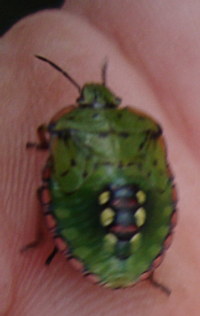
Anyway, they had seemed pretty harmless in their small little shiny baby form – until they monstrously transformed into life-sucking bean-devouring plagues of evil. Garlic spray by this time was incapable of warding off their vampiric tendencies and my carefully arranged companion plants just kind of shrugged their shoulders and like insolent teenagers proclaimed “Whateva, I’m not bovvered!” I’ve never wanted to smack a marigold around before, but it needed a wake-up clip.
Advice on how to organically deal to shield bugs and other such painful pests after the jump.
Flicking through an old Growing Today magazine (December 1995), the wonderful Kay Baxter (Earth mother guru-type of NZ organics) has supplied me with solid answers. Next to the piece was an image of one of my little horrors. Kay wrote:
“You’ll probably notice the first generation of summer shield bugs in the garden now. Pull your resources together and ACT now. Long-term solutions to this tricky problem lie in having the circle complete with predator wasps and pest resistant varieties. But short-term solutions are on our minds at this time of the year. Some people find guinea fowl work well and I’m going to trial them this summer. Other people catch the bugs, blend them and spray the mixture back over the fruit or veges.
I’ve learnt to get in early with the first generation of hatching bugs while they’restill coloured black. Garlic and pyrethrum spray works but you must be regular and thorough and not let the first generation reach maturity and lay the second generation. there are three generations each growing season, the third will over winter.”
Kay also mentions she thinks karo (Pittosporum crassifolius) and kapuka (Grisselinia littoralis) (both New Zealand natives) provide shelter for the shield bug predator wasps.

Leave a Reply
Want to join the discussion?Feel free to contribute!